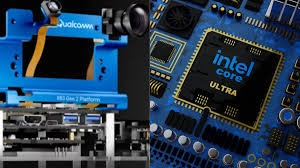In recent years, the dynamics in the semiconductor market have changed significantly, prompting major players to show increased interest in mergers and acquisitions. One of the most talked-about scenarios was Qualcomm’s potential friendly takeover of Intel. This transaction raises numerous questions from a business and antitrust perspective, especially concerning international trade relations and consumer interests.
Over the past 12 months, Intel stock has dropped by 37%, bringing its market capitalization down to $93 billion. Intel’s stock price has been under consistent pressure due to increased competition and internal delays in launching new products. The primary reasons for this decline include worsening financial performance and increasing competition from companies, such as AMD, whose stock has also gained traction, and ARM Holdings, which have significantly improved their technologies and strengthened their market positions. Intel is still trying to regain its footing after experiencing challenges with new processor releases and losing its leadership in the chip segment.
On the other hand, Qualcomm stock has surged by more than 50% over the same period. This reflects the company’s positive momentum, driven by growing demand for 5G technologies and its expanded presence in mobile and embedded chip markets. Qualcomm’s market cap now stands at $188 billion, enhancing its financial strength and potential for further expansion. Investors seeking to analyze such stocks often turn to a stock screener, a tool that helps filter companies based on various metrics like performance, market cap, and sector trends, aiding in informed decision-making.
Recent data suggests that Qualcomm might consider acquiring Intel as a strategic move to expand its technology portfolio and solidify its market position. However, many questions arise about Qualcomm’s motives for merging with Intel, especially if the primary intention is to divest certain Intel assets post-acquisition. This strategy would allow Qualcomm to capitalize on specific business segments while simplifying its operational model.
Nonetheless, this takeover could pose significant risks. Companies across various sectors, including electronics manufacturers, service providers, and even end-users in China and beyond, may oppose such a merger. Chinese antitrust authorities, known for their rigorous scrutiny of transactions, are likely to find ample reasons to block the deal based on potential negative market impacts.
Moreover, from the perspective of European regulators, a potential deal between Qualcomm and Intel could create conditions for dominance in at least two market segments: central processing units for PCs and smartphones, as the combined entity would control over 60% of both markets. For Qualcomm, acquiring only parts of Intel’s assets, rather than the entire company, makes more sense since the latter option could entail regulatory risks. An ideal choice for Intel would be to sell Altera subsidiary, but it remains uncertain whether Qualcomm would need this developer of programmable matrices. Currently, Altera’s assets are valued between $18 and $22 billion, while Intel acquired them for $16.7 billion in 2015.
The takeover of Intel by Qualcomm has implications for consumers in the U.S. and international markets. If Qualcomm gains full control over Intel’s sectors, it could stifle price and technology competition, ultimately impacting product quality. China, being one of the largest markets for electronic equipment, would likely conduct stringent reviews of the deal, concerned about a reduction in market players and potential price hikes for consumers.
Looking ahead, such a deal could dramatically alter the power dynamics within the semiconductor market. If the acquisition is successful, Qualcomm might strengthen its position in mobile chips and 5G technologies, but significant risks remain. Cancellations or blocks of such deals could lead to a decline in Qualcomm’s stock if the company fails to deliver on promises regarding technology improvements and pricing strategies.
Given these factors, investment strategies in this sector should lean towards conservatism. Investors are already eyeing the Dow Jones Index as an indicator of the overall economy and market, and this deal may influence those indices in both the short and long term.
Although Qualcomm may pursue a soft takeover of Intel to dismantle the company, various factors will likely impact the decisions of antitrust authorities. It’s crucial to monitor developments closely, as the outcomes of transactions like this can often be unpredictable.



